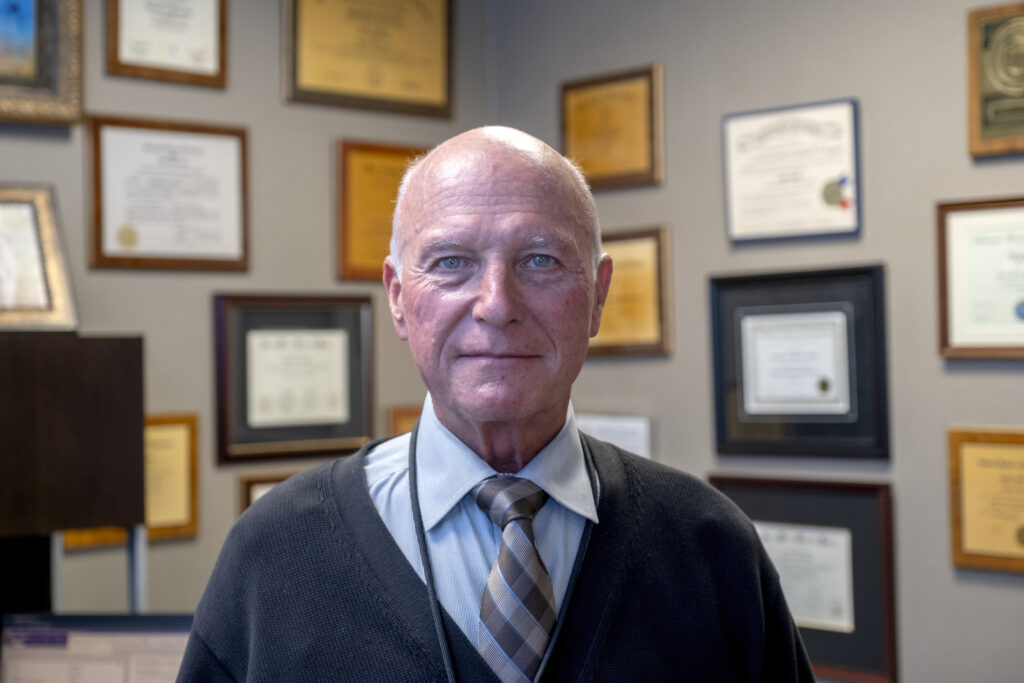Most lower back pain gets better without treatment, but some conditions that cause recurrent pain may require medical or surgical care. Spondylolisthesis, in which spinal vertebrae slip over one another, is one of those conditions.
The word spondylolisthesis (pronounced spohn-di-low-less-THEE-sis) comes from the Greek words spondylos, which means “spine” or “vertebra,” and listhesis, which means “slipping, sliding or movement.”
Dr. Richard Hynes, a board-certified orthopedic surgeon at Health First’s The B.A.C.K. Center, explains that causes include age-related degeneration, trauma and congenital defects.
He adds that the condition affects 20 percent of adults and is more common in women than men.
The National Center for Biotechnology says there is an increased risk in the obese.
Spondylolisthesis can be described according to its degree of severity, with grade 1 being least advanced, and grade 5 most advanced. Grading is measured by how much a vertebral body has slipped forward over the body beneath it.
- Grade 1: 25 percent of vertebral body has slipped forward
- Grade 2: 50 percent
- Grade 3: 75 percent
- Grade 4: 100 percent
In addition to varying degrees of severity, there are several types of spondylolistheses.
The most common is degenerative spondylolisthesis, which is mainly a result of aging. It is caused by osteoarthritis. Most commonly, it affects the L4 disc slipping over the L5 vertebra.
Other types are:
- Congenital spondylolisthesis, which occurs when a baby’s spine doesn’t form the way it should before birth. Misaligned vertebrae put the person at risk of slippage later in life.
- Isthmic spondylolisthesis, which happens due to a crack or fracture that weakens the bone.
- Traumatic spondylolisthesis, which happens when an injury causes vertebrae to slip.
- Pathological spondylolisthesis, which occurs when a disease such as osteoporosis or tumor causes the condition.
- Post-surgical spondylolisthesis, in which slippage is due to spinal surgery.
Low-impact exercises like walking and water aerobics are beneficial for those dealing with spondylolisthesis because the spine isn’t strained. This form of exercise promotes mobility and improves circulation without placing stress on the spinal structures, preventing flare-ups of such pain and neurological symptoms as numbness, tingling and weakness.
Dr. Hynes believes we’re built to be walking machines. “Everything bad happens when you stop walking,” he says. “If you walk in your 70s, you’ll walk in your 80s.”
Gentle stretching and strengthening exercises are also beneficial. Stretching helps patients improve and maintain their range of motion while reducing muscle tension.
Strengthening exercises for the back and core muscles improve support for the spine, preventing stress on the spine during a range of activities.
The Hospital for Special Surgery says that treatment varies by individual case and grade.
Nonsurgical treatments may include activity reduction, a back brace, physical therapy and/or corticosteroid injections. In severe cases, spine surgery may be required to alleviate chronic pain or nerve damage.
Cleveland Clinic says symptoms can vary from none to severe pain. Many people have this condition and don’t even know it. If you do have symptoms, lower back pain is typically the main one, although the pain may extend to the buttocks and down the thighs. You may also experience:
- Muscle spasms in the back of the thighs.
- Back stiffness.
- Difficulty walking or standing for long periods.
- Pain when bending over.
- Numbness, weakness or tingling in the foot.
Should your spondylolisthesis reach a point where you do need surgery, Dr. Hynes says new robotic procedures are “magnificent.” He adds that otherwise healthy people can have surgery into their 80s and 90s.
A misconception about robotic spine surgery is that the robot performs the surgery, which is not true. The robotic arm is not capable of moving on its own. A surgeon pre-programs the robot and controls every movement of the robotic arm using a console that is connected to the robotic apparatus.
Richard Hynes, MD, is a Health First board-certified Orthopedic Surgeon who specializes in minimally invasive and robotic spine surgeries. He completed a Spine Surgery Fellowship at Harvard University, Beth Israel Hospital in Boston, and did his residency and general surgery internship at Tripler Army Medical Center, University of Hawaii. His medical degree is from Rutgers, and he is a Diplomate of the American Board of Orthopaedic Surgery, the National Board of Examiners, the North American Spine Society, and the American Board of Spine Surgeons. He practices at The B.A.C.K. Center, 2222 S. Harbor City Blvd., Melbourne.
Call 321-723-7716 for an appointment.

